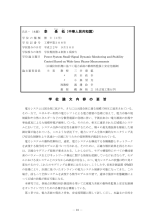Power system small-signal dynamic monitoring and stability control based on wide-area phasor measurements 広域位相計測に基づく電力系統の動特性監視と安定化制御
この論文にアクセスする
この論文をさがす
著者
書誌事項
- タイトル
-
Power system small-signal dynamic monitoring and stability control based on wide-area phasor measurements
- タイトル別名
-
広域位相計測に基づく電力系統の動特性監視と安定化制御
- 著者名
-
李, 長松
- 著者別名
-
リ, チャンソン
- 学位授与大学
-
九州工業大学
- 取得学位
-
博士(工学)
- 学位授与番号
-
工博甲第308号
- 学位授与年月日
-
2010-09-30
注記・抄録
博士論文
九州工業大学博士学位論文(要旨) 学位記番号:工博甲第308号 学位授与年月日:平成22年9月30日
1. Introduction||2. Phasor Measurement Technology||3. Measurement-based Analysis Theory||4. Single-mode-oriented Estimation of Power Oscillation Based on Phasor Measurements and Auto-spectrum-based FFT Filter||5. Participation Weight Estimation in Power Oscillation Based on Phasor Measurements and Auto-spectrum Analysis||6. Modeling of Two-Area HVDC-Connected-System for Load Frequency Control Based on Application of the CampusWAMS||7. Controller Design for Power Oscillation Damping Improvement Based on Phasor Measurements||8. Conclusions
At present, modern power systems around the world are more interconnected in nation-wide and even continent-wide scope. These interconnected wide-area systems are faced with a series of challenging issues concerning the stability and control of overall system, which result from the lack of transmission lines expansion, unprecedented increase in electricity demand and tie-line power flow, deregulation of electricity markets, and rapid growth in distributed generations. Under this circumstance, any failure in the planning, operation, protection and control of any part of the entire power system could evolve into the cause of cascading events that may eventually lead to a large area power blackout. Among many expected features of a future Smart Grid, one is essential: self-healing from various power system disturbances, which requires not only more rapid and coordinated recovery after disturbances but also prevention of large area outages by all means. Therefore, these challenging issues set new demand on the development of more rapid, effective, accurate methods for power system dynamic monitoring and stability control.Traditionally, all aspects of the analysis of power system dynamic and stability are built on the dependence of the mathematic model of power system components and network. In brief, the traditional approach is model-based - for the purpose of performing any analysis, a mathematic model which is appropriate to the concerned analysis has to be constructed in advance. The model-based approach has following significant deficiencies. Firstly, the information about all components' parameter and network configuration has to be known before the model construction. Secondly, the constructed model always shows limitation and incapability of describing the true characteristic of practical power system. Lastly, many operation or control decisions based on the system model are only applicable to the operation condition when these decisions are made.The advent and deployment of phasor measurement units (PMUs) enables the measurement-based approach to monitoring and control power system dynamic. For the measurement-based approach, a beforehand prepared mathematic model based on the knowledge of overall system information is not necessary and only the measurements of output (and sometimes, input) of power system are available. In principle, the measurement-based approach constructs an online snapshot-model of power system dynamic using these real system measurements, which can achieve quick, timely and accurate representation of real system dynamic. Compared to the conventional measurement from SCADA (supervisory control and data acquisition) system, phasor measurement provides the crucial information of phase angle which has close relation with power system dynamic and stability. More importantly, the time synchronization information is embedded in phasor measurement so that phasor data from multiple distant locations in a wide-area power system can be correctly and accurately processed.Accordingly, under the concept of measurement-based approach, this work studies the applications of wide-area phasor measurements to power system small-signal dynamic monitoring and stability control by utilizing various techniques such as digital signal processing, system identification and optimization. Basically, there are indirect and direct ways to take advantage of phasor data for measurement-based power system dynamic monitoring and stability control. For indirect situation, phasor measurements are used to estimate a traditional dynamic model of power system when the base-line information of the concerned system is no available or to validate an existing system dynamic model when the base-line data is available. In this work, a method of modeling a HVDC-only-interconnected two-area power system for describing the effect of its load frequency control is proposed based on wide-area phasor measurements (Chapter 6). In particular, without knowledge of the detailed base-line data of the studied system, the system model parameters that relates to two-area load frequency control are optimally estimated using phasor measurements during the period of an identifiable system disturbance event.For most situations, phasor measurements can be directly adopted to realize the power system dynamic monitoring or stability controller design. In this work, the single-mode-oriented oscillation data extraction and eigenvalue estimation method and the method of estimating the participation level of generators in one concerned interarea oscillation mode are proposed based on wide-area phasor measurements and auto-spectrum analysis (Chapter 4 and Chapter 5). The auto-spectrum analysis of phasor measurements is adopted to identify the existence of oscillation modes and further to estimate the dominant frequency of each oscillation mode as well as the relative participation level of generators in one oscillation mode. Based on this information, the oscillation data corresponding to the concerned single mode can be accurately extracted from the original phasor measurements to construct an oscillation model which represents the characteristic of the concerned mode.Furthermore, the controller design scheme in order for improving the damping of one concerned interarea oscillation mode is proposed based on wide-area phasor measurements (Chapter 7). As one of potential damping improvement channels, a HVDC supplementary damping controller is designed using the proposed scheme. Online controller parameter self-tuning strategy is also discussed in order to maintain the sufficient damping when power system is operating under normal but frequent changing conditions.Compared with the traditional model-based methods for power oscillation analysis or damping controller design, all proposed methods in this thesis are output-and measurement-only-based. Evaluation results using CampusWAMS (campus wide area measurement system) and simulation systems are provided to show the effectiveness of the proposed methods, which are potentially feasible and applicable to online practical WAMS applications.
九州工業大学博士学位論文 学位記番号:工博甲第308号 学位授与年月日:平成22年9月30日
平成22年度
